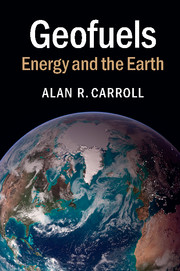Book contents
- Frontmatter
- Contents
- Acknowledgments
- 1 Introduction
- 2 The Living Earth
- 3 Warmed from Above: Solar Energy
- 4 Wind, Water, and Waves: Energy from the Fluid Earth
- 5 Covered in Green: Biofuels Basics
- 6 Fossil Farming: The Geologic Underpinnings of Biofuels
- 7 The Light of an Ancient Sun: Fossil Fuel Origins
- 8 Digging for Daylight: Coal and Oil Shale
- 9 Skimming the Cream: Conventional Oil and Gas
- 10 Stuck in the Mud: Fossil Fuels That Fail to Flow
- 11 Petrified Petroleum: Oil Sand and Gas Hydrate
- 12 Water, Water, Everywhere
- 13 Primordial Power: Geothermal and Nuclear
- 14 Out of Sight, Out of Mind: Geologic Waste Disposal
- 15 How Long Is Forever? Energy and Time
- 16 Conclusions
- Index
- References
6 - Fossil Farming: The Geologic Underpinnings of Biofuels
Published online by Cambridge University Press: 05 March 2015
- Frontmatter
- Contents
- Acknowledgments
- 1 Introduction
- 2 The Living Earth
- 3 Warmed from Above: Solar Energy
- 4 Wind, Water, and Waves: Energy from the Fluid Earth
- 5 Covered in Green: Biofuels Basics
- 6 Fossil Farming: The Geologic Underpinnings of Biofuels
- 7 The Light of an Ancient Sun: Fossil Fuel Origins
- 8 Digging for Daylight: Coal and Oil Shale
- 9 Skimming the Cream: Conventional Oil and Gas
- 10 Stuck in the Mud: Fossil Fuels That Fail to Flow
- 11 Petrified Petroleum: Oil Sand and Gas Hydrate
- 12 Water, Water, Everywhere
- 13 Primordial Power: Geothermal and Nuclear
- 14 Out of Sight, Out of Mind: Geologic Waste Disposal
- 15 How Long Is Forever? Energy and Time
- 16 Conclusions
- Index
- References
Summary
We may be quite sure that among plants, as well as among animals, there is a limit to improvement, though we do not exactly know where it is.
Thomas Robert Malthus, 1798In 1902 the English author W. W. Jacobs penned a short story entitled “The Monkey's Paw”, about a shriveled artifact with the magical power to grant its owner three wishes. Unfortunately those wishes resulted in unexpected and terrible consequences that far outweighed their benefits, to the bitter regret of the wisher. The cautionary message of this tale is that we should be very careful any time something valuable is offered without apparent cost.
Biofuels promise to grant only two wishes rather than three, but they are good ones: reduced greenhouse gas emissions and energy renewability. However, does the granting of these wishes carry a dark side that might outweigh their apparent benefit? The most obvious concern is the potential for biofuels to compete with food production. Part of the reason we can seriously consider biofuels at all is the “Green Revolution”, a dramatic increase in global farm output that occurred during the latter half of the 20th century. According to data published by the U.N. Food and Agriculture Organization, world production of rice, wheat, and corn roughly tripled between 1961 and 2007. Some individual crops or countries experienced even larger increases. For example, average corn yields in the United States increased roughly fivefold between 1950 and 2000, after having been essentially flat during the first half of the century (Figure 6.1). Total wheat production in China increased more than sixfold during 1961–2008.
This agricultural bounty offers the hope that we can burn our cake, and eat it too. However, increased crop yields carry their own price, in the form of nonrenewable Earth resources needed to support them. Leading the list are fossil fuels, used for everything from powering tractors to producing nitrogen fertilizer. Other vital fertilizers are also derived from limited geologic deposits.
- Type
- Chapter
- Information
- GeofuelsEnergy and the Earth, pp. 103 - 122Publisher: Cambridge University PressPrint publication year: 2015



